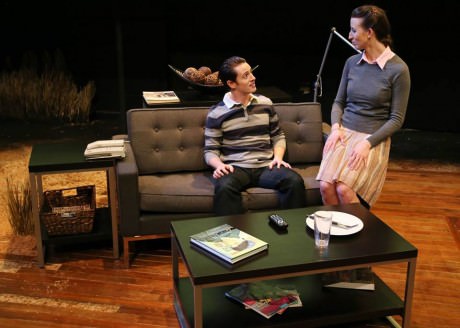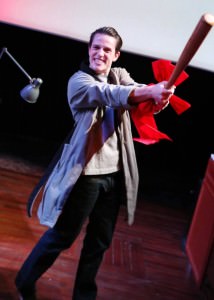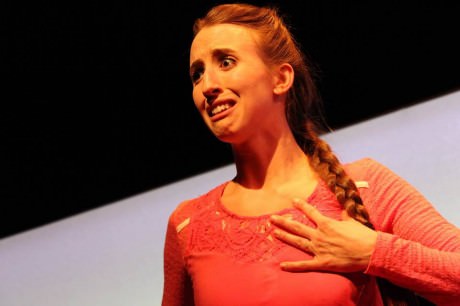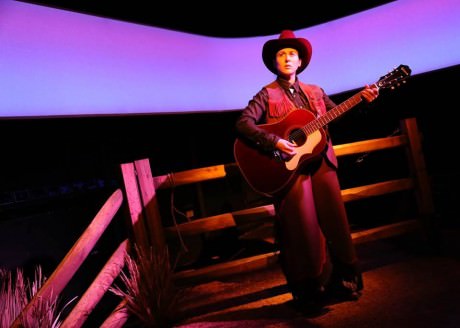Burgeoning playwright Sarah Ruhl is featured as the start of the season at No Rules Theatre Company as they present the Washington DC premier of Late: A Cowboy Song. Directed by Rex Daugherty, this witty bubbling new work presents an in-depth look at the idiosyncrasies of life in regards to gender roles and love. A compelling piece of quirky drama, with an urban fairytale feel to the story, there are laughs and moments of deeply ponderous emotion to behold in this rapid moving performance.

Director Rex Daugherty creates a plethora of moments to appease the visual and aural senses. Working with Lighting Designer Cory Ryan Frank and Sound Designer Brandon Roe, the trio compose moments of intricate emotional existences between the characters on the stage that exist both in the world of the play and surreally outside of it. Frank’s use of the stage-wide screen to project various colored lights creates atmospheres rather than just simple effects; moving time with shifts in tones of sunset to twilit dusk and night-blue sky. It’s the moments of cacophonous sound designed by Roe that occur between scene shifts that captivate the audience’s attention; swirls and whirls of sounds thundering together into the chaotic rapture that is everyday life, further accentuating the passage of time.
There is a stunning moment of aesthetic madness that comes crashing over the audience, drowning them in visual and aural stimuli; Roe’s sounds of the holidays combined with the spastic bursts of colored lights on Frank’s horizontal light screen meld together in one enormous wave of blurred confusion that washes the lone male character of the show up in a frenzy while completely blowing the show’s protagonist over with its essence. The trio share a vision and translate these notions exceedingly well to the audience, enhancing the overall experience of the production.
The play itself is a fascinating piece of work; on the surface an examination of life and the nuances therein between grade school sweethearts, Crick and Mary, who have stayed together from second grade into the swells of adulthood. Ruhl digs beneath the surface in a subtle fashion, little pockets of subtext burbling up into the conversations and moments of action that occur to really draw the audience’s focal point to the bigger issue at hand: gender identities. Roles of society, what’s accepted as normal or traditional for the role of a male or a female and how these social constructs of gender influence and affect the everyday moments of living are featured as central, albeit covert, topics of the play.
Director Rex Daugherty finds a unique approach to the age-old fiction device of “show, don’t tell” and utilizes it upon the stage in this production, creating wildly intriguing moments of action without words. Daugherty often fills the shifts between scenes— particularly when major events have just happened or are about to happen— with intense moments of movement and highly specialized interpretive choreography. The almost ethereal dreamlike sequence – just as Mary goes into labor – is worth mentioning as it mimics a ballet of sorts, fully encompassing the emotions of birth in the performers’ body language.

The one drawback I had was the lack of maximum expression when it comes to the performers playing the stakes of their characters out both verbally and emotionally. This occurs mostly with Crick (Chris Dinolfo) where everything he does or says is done and said with an extremely exuberant passion and uncontrollable energy behind it. While at first it seems quirky and obnoxious it quickly becomes dull by the end of the production, giving Dinolfo’s character no chance to really grow or change because when he hits those dynamic moments of emotional extremity there is no difference between them and the rest of his moments. This fuels the urban fairytale feel of the production and is thus a double-edged sword, serving a purpose while simultaneously feeling unrewarding.
Dinolfo does an exceptional job of carrying out his character’s maniacal tendencies, overreacting and over-responding to the situation, creating tension and drama where there previously was none. His interactions with Mary (Sarah Olmsted Thomas) oscillate from extreme desperate love to harrowed fury driven by insecurities, and while they are often received as melodramatic, he commits fully to the character never backing down from these bold choices.

Thomas, as the show’s protagonist, brings a dreamy yet pleasantly aloof quality to the character. There is a strong current of naiveté that flows through Mary and Thomas delivers that in a balanced fashion, keeping her simplistic dull nature believable yet optimistic. Thomas manages to embody this strange character as if it was a wispy cloud on a sunny day— floating but never grounded yet still totally present. Her moments of emotional outburst, especially when directed at Crick, are poignant and delivered in sharp contrast to her otherwise hopeful existence. These moments of serene hope juxtapose with ease against Mary’s tendency to have spastic and unrealistic thoughts about the future.
It’s Thomas’ unspoken relationship that develops with Red (Alyssa Wilmoth) that really hones the focus of the performance to the playwright’s main message. Wilmoth is an exceptional performer with a stunning voice reminiscent of Patsy Cline when she begins to sing the various songs composed into the piece by Daugherty and Co-Composer Kinsey Charles. Her voice is rich and emotionally charged for these songs, making them echoes of emotional reality, sometimes a lullaby and sometimes a crooned ballad of heartache and soul.

Wilmoth’s accent and overall approach to the slow ‘cowboy’ drawl draws the audience into her character’s reality, and while she too presents a simplistic nature it is more focused than the simplicity presented in Mary. It’s her moments of reflective silence, and occasional glances that really stir up both raucous laughter and deep consideration from those of us watching. It’s what goes unsaid for Wilmoth that makes her character shine, though she is equally impressive when delivering text. The moment that she shares upon the ‘horse’ with Thomas is one of the most thought-provoking and stunning in the production as the intricate lighting and sound design elements align and the pair share something truly wild and freeing in that scene.
Late: A Cowboy Song has a limited run so be sure to get your tickets soon. It’s an exceptional way to start the 2014 season at No Rules Theatre Company.
Running Time: One hour and 45 minutes, with no intermission.
Late: A Cowboy Song plays through January 19, 2014 at No Rules Theatre Company in Signature Theatre’s ARK— 4200 Campbell Avenue, in Arlington, VA. For tickets, call the box office at (703) 820-9771, or purchase them online.
LINK
What’s New at No Rules Theatre Company This Season by Artistic Director Joshua Morgan.






Usually feel that reviews by Amanda Gunther are “right on” but in this case, disagree w/ her comments re “maximum expression” and feel that Rex Daugherty intentionally directed the production in such a way to enhance the complexity. Fine acting by all 3! Btw, Alyssa Wilmoth who plays “Red”, acted in “Contractions” x from Holly Twyford — I didn’t recognize her which is a coup to her acting ability. Who knew she could sing?! Kudos to No Rules. Very short run so get tix now.